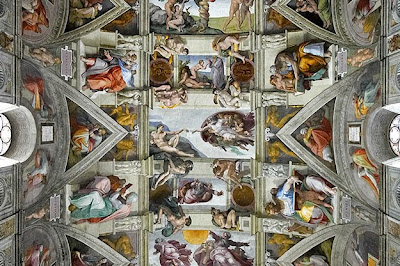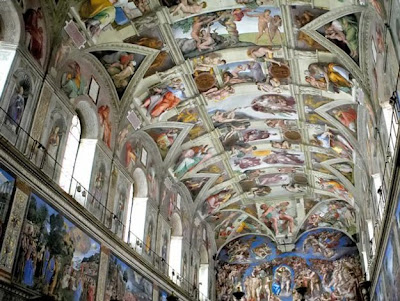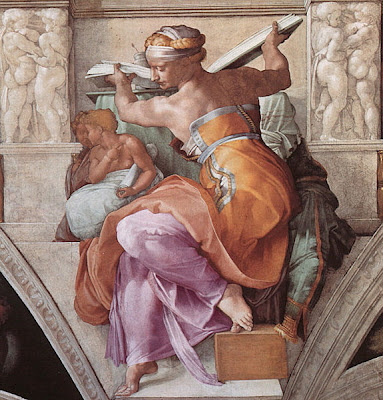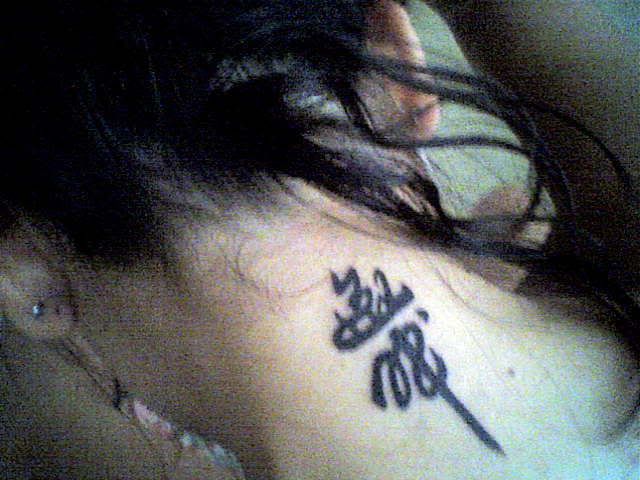Michelangelo (full name: Michelangelo di Lodovico Buonarroti Simoni) was born at Caprese, a village in Florentine territory, where his father, named Ludovico Buonarroti Simoni was the resident magistrate. A few weeks after Michelangelo's birth the family returned to Florence, and, in 1488, after overcoming parental opposition he was formally apprenticed to Domenico Ghirlandaio for a term of three years. Later in life Michelangelo tried to suppress this fact, probably to make it seem that he had never had an ordinary workshop training; for it was he more than anyone else who introduced the idea of the 'Fine Arts' having no connection with the craft that painting had always previously been.


His stay in the Ghirlandaio shop must also have coincided with his beginning to work as a sculptor in the Medici Garden, where antiques from their collection were looked after by Bertoldo. Although this connection drew him into the Medici circle as a familiar, the account by Vasari of an established 'school' is now discredited. It must, however, have been Ghirlandaio who taught him the elements of fresco technique, and it was probably also in that shop that he made his drawings after the great Florentine masters of the past (copies after Giotto and Masaccio; now in the Louvre, in Munich, and in Vienna). Michelangelo produced at least two relief sculptures by the time he was 16 years old, the Battle of the Centaurs and the Madonna of the Stairs (both 1489-92, Casa Buonarroti, Florence), which show that he had achieved a personal style at a very early age.
In 1492, Lorenzo de' Medici died. Michelangelo then studied anatomy with the help of the Prior of the Hospital of Sto Spirito, for whom he appears to have carved a wooden crucifix for the high altar. A wooden crucifix found there (now in the Casa Buonarroti) has been attributed to him by some scholars. The next few years were marked by the expulsion of the Medici and the gloomy Theocracy set up under Savonarola, but Michelangelo avoided the worst of the crisis by going to Bologna and, in 1496, to Rome. He settled for a time in Bologna, where in 1494 and 1495 he executed several marble statuettes for the Arca (Shrine) di San Domenico in the Church of San Domenico.


In Rome he carved the first of his major works, the Bacchus (Florence, Bargello) and the St Peter's Pietà, which was completed by the turn of the century. It is highly finished and shows that he had already mastered anatomy and the disposition of drapery, but above all it shows that he had solved the problem of the representation of a full-grown man stretched out nearly horizontally on the lap of a woman, the whole being contained in a pyramidal shape.
The Pietà made his name and he returned to Florence in 1501 as a famous sculptor, remaining there until 1505. During these years he was extremely active, carving the gigantic David (1501-4, now in the Accademia), the Bruges Madonna (Bruges, Notre Dame), and beginning the series of the Twelve Apostles for the Cathedral which was commissioned in 1503 but never completed (the St Matthew now in the Accademia is the only one which was even blocked in). At about this time he painted the Doni Tondo of the Holy Family with St John the Baptist (Florence, Uffizi) and made the two marble tondi of the Madonna and Child (Florence, Bargello; London, Royal Academy).



After the completion of the David in 1504 he began to work on the cartoon of a huge fresco in the Council Hall of the new Florentine Republic, as a pendant to the one already commissioned from Leonardo da Vinci. Both remained unfinished and the grandiose project of employing the two greatest living artists on the decoration of the Town Hall of their native city came to nothing. Of Michelangelo's fresco, which was to represent the Battle of Cascina, an incident in the Pisan War, we now have a few studies by him and copies of a fragment of the whole full-scale cartoon which once existed (the best copy is the painting in Lord Leicester's Collection, Holkham, Norfolk). The cartoon, which is known as the Bathers, was for many years the resort of every young artist in Florence and, by its exclusive stress on the nude human body as a sufficient vehicle for the expression of alt emotions which the painter can depict, had an enormous influence on the subsequent development of Italian art - especially Mannerism - and therefore on European art as a whole. This influence is more readily detectable in his next major work, the ceiling of the Sistine Chapel. In fact, however, the Battle of Cascina was left incomplete because the Signoria of Florence found it expedient to comply with a request from the masterful Pope Julius II, who was anxious to have a fitting tomb made in his lifetime.
The Julius Monument was, in Michelangelo's own view, the Tragedy of the Tomb. This was partly because Michelangelo and Julius had the same ardent temperament - they admired each other greatly - and very soon quarrelled, and partly because after the death of Julius in 1513, Michelangelo was under constant pressure from successive Popes to abandon his contractual obligations and work for them while equally under pressure from the heirs of Julius, who even went so far as to accuse him of embezzlement. The original project for a vast free-standing tomb with forty figures was substantially reduced by a second contract (1513), drawn up after Julius's death; under this contract the Moses, which is the major figure on the extant tomb, was prepared as a subsidiary figure. Two others, the Slaves in the Louvre, were made under this contract but were subsequently abandoned. The third contract (1516) was followed by a fourth (1532), and a fifth and final one in 1542, under the terms of which the present miserably mutilated version of the original conception was carried out by assistants, under Michelangelo's supervision, in S. Pietro in Vincoli (Julius's titular church) in 1545. Michelangelo was then 70 and had spent nearly forty years on the tomb.


Meanwhile, the original quarrel of 1506 with Julius was made up and Michelangelo executed a colossal bronze statue of the Pope as an admonition to the recently conquered Bolognese (who destroyed it as soon as they could, in 1511). In 1508, back in Rome, he began his most important work, the ceiling of the Sistine Chapel in the Vatican for Julius, who, as usual, was impatient to see it finished. Dissatisfied with the normal working methods and with the abilities of the assistants he had engaged, Michelangelo determined to execute the whole of this vast work virtually alone. Working under appalling difficulties (amusingly described in one of his own poems), most of the time leaning backwards and never able to get far enough away from the ceiling to be able to see what he was doing, he completed the first half (the part nearer to the door) in 1510. The whole enormous undertaking was completed in 1512, Michelangelo being by then so practised that he was able to execute the second half more rapidly and freely. It was at once recognized as a supreme work of art, even at the moment when Raphael was also at work in the Vatican Stanze. From then on Michelangelo was universally regarded as the greatest living artist, although he was then only 37 and this was in the lifetimes of Leonardo and Raphael (who was even younger). From this moment, too, dates the idea of the artist as in some sense a superhuman being, set apart from ordinary men, and for the first time it was possible to use the phrase 'il divino Michelangelo' without seeming merely blasphemous.

The Sistine Ceiling is a shallow barrel vault divided up by painted architecture into a series of alternating large and small panels which appear to be open to the sky. These are the Histories. Each of the smaller panels is surrounded by four figures of nude youths - the Slaves, or Ignudi - who are represented as seated on the architectural frame and who are not of the same order of reality as the figures in the Histories, since their system of perspective is different. Below them are the Prophets and Sibyls, and still lower, the figures of the Ancestors of Christ. The whole ceiling completes the chapel decoration by representing life on earth before the Law: on the walls is an earlier cycle of frescoes, painted in 1481-82, representing the Life of Moses (i.e. the Old Dispensation) and the Life of Christ (the New Dispensation). The Histories begin over the altar and work away from it (though they were painted in the reverse direction): the first scene represents God alone, in the Primal Act of Creation, and the story continues through the rest of the Creation to the Fall, the Flood, and the Drunkenness of Noah, representing the human soul at its furthest from God. The whole conception owes much to the Neoplatonic philosophy current in Michelangelo's youth in Florence, perhaps most in the idea of the Ignudi, perfect human beauty, on the level below the Divine story. Below them come the Old Testament Prophets and the Seers of the ancient world who foretold the coming of Christ; while the four corners have scenes from the Old Testament representing Salvation. The Prophet Jonah is above the altar, since his three days in the whale were held to prefigure the Resurrection. On the lowest parts - and very freely painted - are the human families who were the Ancestors of Christ. There can be no doubt that the splendour of the conception and the size of the task distracted Michelangelo from the Tomb, but he at once returned to it as soon as the ceiling was finished, from 1513 to 1516, when he returned to Florence to work for the Medici. (For details on the frescoes in the Sistine Chapel take a guided tour.)
His new master was Pope Leo X, the younger son of Lorenzo de Medici, who had known Michelangelo from boyhood; he now commissioned him to complete the façade of S. Lorenzo, the family church in Florence. Michelangelo wasted four years on this and it came to nothing. In 1520 he began planning the Medici Chapel, a funerary chapel in honour of four of the Medici - two of them by no means the most glorious of their family. The chapel is attached to S. Lorenzo. Leo X died in 1521 and it was not until after the accession of another Medici Pope, Clement VII, in 1523 that the project was resumed. Work began in earnest in 1524 and at the same time he was commissioned to design the Laurenziana Library in the cloister of the same church. Both these buildings are turning-points in architectural history, but the sculptural decoration of the chapel (an integral part of the architecture) was never completed, although the figures of Giuliano and Lorenzo de' Medici set over their tombs, eternally symbolizing the Active and the Contemplative Life, above the symbols of Time and Mortality - Day and Night, Dawn and Evening - are among his finest creations. The unfinished Madonna was meant to be the focal point of the chapel.
In 1527, the Medici were again expelled from Florence, and Michelangelo, who was politically a Republican in spite of his close ties with the Medici, took an active part in the 1527-29 war against the Medici up to the capitulation in 1530 (although in a moment of panic he had fled in 1529) and supervised Florentine fortifications. During the months of confusion and disorder in Florence, when he was proscribed for his participation in the struggle, it would appear that he was hidden by the Prior of S. Lorenzo. A number of drawings on the walls of a concealed crypt under the Medici Chapel have been attributed to him, and ascribed to this period. After the reinstatement of the Medici he was pardoned, and set to work once more on the Chapel which was to glorify them until, in 1534, he left Florence and settled in Rome for the thirty years remaining to him.
He was at once commissioned to paint his next great work, the Last Judgement on the altar wall of the Sistine Chapel, which affords the strongest possible contrast with his own Ceiling. He began work on it in 1536. In the interval there had been the Sack of Rome and the Reformation, and the confident humanism and Christian Neoplatonism of the Ceiling had curdled into the personal pessimism and despondency of the Judgement. The very choice of subject is indicative of the new mood, as is the curious fact that the mouth of Hell gapes over the altar itself where, during services, stands a crucifix symbolizing Christ standing between Man and Doom. It was unveiled in 1541 and caused a sensation equalled only by his own work of thirty years earlier, and was the only work by him to be as much reviled as praised, and only narrowly to escape destruction, though it did not escape the mutilation of having many of the nude figures 'clothed' after his death. Most of the ideas of Mannerism are traceable implicitly or explicitly in the Judgement and, more than ever, it served to imprint the idea that the scope of painting is strictly limited to the exploitation of the nude, preferably in foreshortened - and therefore difficult - poses. Paul III, who had commissioned the Judgement, immediately commissioned two more frescoes for his own chapel, the Cappella Paolina; these were begun in 1542 and completed in 1550. They represent the Conversion of St Paul and the Crucifixion of St Peter.
Michelangelo was now 75 years old. Earlier, in 1538-39, plans were under way for the remodeling of the buildings surrounding the Campidoglio (Capitol) on the Capitoline Hill, the civic and political heart of the city of Rome. Although Michelangelo's program was not carried out until the late 1550s and not finished until the 17th century, he designed the Campidoglio around an oval shape, with the famous antique bronze equestrian statue of the Roman emperor Marcus Aurelius in the center. For the Palazzo dei Conservatori he brought a new unity to the public building façade, at the same time that he preserved traditional Roman monumentality. However, since 1546 he had been increasingly active as an architect; in particular, he was Chief Architect to St Peter's and was doing more there than had been done for thirty years. This was the greatest architectural undertaking in Christendom, and Michelangelo did it, as he did all his late works, solely for the glory of God.
In his last years he made a number of drawings of the Crucifixion, wrote much of his finest poetry, and carved the Pietà (now in Florence Cathedral Museum) which was originally intended for his own tomb, as well as the nearly abstract Rondanini Pietà (Milan, Castello). This last work, in which the very forms of the Dead Christ actually merge with those of His Mother, is charged with an emotional intensity which contemporaries recognized as Michelangelo's 'terribilità'. He was working on it to within a few days of his death, in his 89th year, on 18 February 1564. There is a whole world of difference between it and the 'beautiful' Pietà in St Peter's, carved some sixty-five years earlier.
Unlike any previous artist, Michelangelo was the subject of two biographies in his own lifetime. The first of these was by Vasari, who concluded the first (1550) edition of his 'Vite' with the Life of one living artist, Michelangelo. In 1553 there appeared a 'Life of Michelangelo' by his pupil Ascanio Condivi (English translations 1903, 1976 and 1987); this is really almost an autobiography, promoted by Michelangelo to correct some errors of Vasari and to shift the emphasis in what Michelangelo regarded as a more desirable direction. Vasari, however, became more and more friendly with Michelangelo and was also his most devoted and articulate admirer, so that the very long Life which appears in Vasari's second edition (1568), after Michelangelo's death, gives us the most complete biography of any artist up to that time and is a trustworthy guide to the feelings of contemporaries about the man who can lay claim to be the greatest sculptor, painter and draughtsman that has ever lived, as well as one of the greatest architects and poets. He is the archetype of genius.
Pure fresco was his preferred painting technique; he despised oil-painting, though the now authenticated unfinished Entombment (London, National Gallery) is in oil over a tempera underpainting. The Doni Tondo is in tempera. In sculpture, his usual method was to outline his figure on the front of the block and, as he himself wrote, to 'liberate the figure imprisoned in the marble', by working steadily inwards, with perhaps a few more finished details. Occasionally he made drawings for parts of a figure, and a few small wax models survive as well as one large one, made for the guidance of assistants working on the Medici Chapel figures. The four abandoned Slaves intended for a later version of the Julius Tomb (Florence, Accademia) and the two marble tondi left unfinished in 1505 provide fine examples of his direct carving technique and his consistent use of various sizes of claw chisel. No modelli exist for any paintings or frescoes, and only one cartoon (London, British Museum), made to help Condivi, has survived.
Apart from the works mentioned above, there are others in Florence (Bargello, Santo Spirito - the house of his family, which contains relics of him - and Palazzo della Signoria) and in Siena, Rome (Santa Maria sopra Minerva), and St Petersburg (The Hermitage). There are also some 500 drawings by him, the majority of which are in Windsor (Royal Collection), Florence (Casa Buonarroti), and Paris.










 Cobra tattoo designs image@istockphoto.com
Cobra tattoo designs image@istockphoto.com tribal Cobra tattoo image@deviantart.com _by_shwokeeshplat
tribal Cobra tattoo image@deviantart.com _by_shwokeeshplat What's the meaning of Cobra Tattoo ?
What's the meaning of Cobra Tattoo ?



 In Rome he carved the first of his major works, the Bacchus (Florence, Bargello) and the St Peter's Pietà, which was completed by the turn of the century. It is highly finished and shows that he had already mastered anatomy and the disposition of drapery, but above all it shows that he had solved the problem of the representation of a full-grown man stretched out nearly horizontally on the lap of a woman, the whole being contained in a pyramidal shape.
In Rome he carved the first of his major works, the Bacchus (Florence, Bargello) and the St Peter's Pietà, which was completed by the turn of the century. It is highly finished and shows that he had already mastered anatomy and the disposition of drapery, but above all it shows that he had solved the problem of the representation of a full-grown man stretched out nearly horizontally on the lap of a woman, the whole being contained in a pyramidal shape. 



 Meanwhile, the original quarrel of 1506 with Julius was made up and Michelangelo executed a colossal bronze statue of the Pope as an admonition to the recently conquered Bolognese (who destroyed it as soon as they could, in 1511). In 1508, back in Rome, he began his most important work, the ceiling of the Sistine Chapel in the Vatican for Julius, who, as usual, was impatient to see it finished. Dissatisfied with the normal working methods and with the abilities of the assistants he had engaged, Michelangelo determined to execute the whole of this vast work virtually alone. Working under appalling difficulties (amusingly described in one of his own poems), most of the time leaning backwards and never able to get far enough away from the ceiling to be able to see what he was doing, he completed the first half (the part nearer to the door) in 1510. The whole enormous undertaking was completed in 1512, Michelangelo being by then so practised that he was able to execute the second half more rapidly and freely. It was at once recognized as a supreme work of art, even at the moment when Raphael was also at work in the Vatican Stanze. From then on Michelangelo was universally regarded as the greatest living artist, although he was then only 37 and this was in the lifetimes of Leonardo and Raphael (who was even younger). From this moment, too, dates the idea of the artist as in some sense a superhuman being, set apart from ordinary men, and for the first time it was possible to use the phrase 'il divino Michelangelo' without seeming merely blasphemous.
Meanwhile, the original quarrel of 1506 with Julius was made up and Michelangelo executed a colossal bronze statue of the Pope as an admonition to the recently conquered Bolognese (who destroyed it as soon as they could, in 1511). In 1508, back in Rome, he began his most important work, the ceiling of the Sistine Chapel in the Vatican for Julius, who, as usual, was impatient to see it finished. Dissatisfied with the normal working methods and with the abilities of the assistants he had engaged, Michelangelo determined to execute the whole of this vast work virtually alone. Working under appalling difficulties (amusingly described in one of his own poems), most of the time leaning backwards and never able to get far enough away from the ceiling to be able to see what he was doing, he completed the first half (the part nearer to the door) in 1510. The whole enormous undertaking was completed in 1512, Michelangelo being by then so practised that he was able to execute the second half more rapidly and freely. It was at once recognized as a supreme work of art, even at the moment when Raphael was also at work in the Vatican Stanze. From then on Michelangelo was universally regarded as the greatest living artist, although he was then only 37 and this was in the lifetimes of Leonardo and Raphael (who was even younger). From this moment, too, dates the idea of the artist as in some sense a superhuman being, set apart from ordinary men, and for the first time it was possible to use the phrase 'il divino Michelangelo' without seeming merely blasphemous.  The Sistine Ceiling is a shallow barrel vault divided up by painted architecture into a series of alternating large and small panels which appear to be open to the sky. These are the Histories. Each of the smaller panels is surrounded by four figures of nude youths - the Slaves, or Ignudi - who are represented as seated on the architectural frame and who are not of the same order of reality as the figures in the Histories, since their system of perspective is different. Below them are the Prophets and Sibyls, and still lower, the figures of the Ancestors of Christ. The whole ceiling completes the chapel decoration by representing life on earth before the Law: on the walls is an earlier cycle of frescoes, painted in 1481-82, representing the Life of Moses (i.e. the Old Dispensation) and the Life of Christ (the New Dispensation). The Histories begin over the altar and work away from it (though they were painted in the reverse direction): the first scene represents God alone, in the Primal Act of Creation, and the story continues through the rest of the Creation to the Fall, the Flood, and the Drunkenness of Noah, representing the human soul at its furthest from God. The whole conception owes much to the Neoplatonic philosophy current in Michelangelo's youth in Florence, perhaps most in the idea of the Ignudi, perfect human beauty, on the level below the Divine story. Below them come the Old Testament Prophets and the Seers of the ancient world who foretold the coming of Christ; while the four corners have scenes from the Old Testament representing Salvation. The Prophet Jonah is above the altar, since his three days in the whale were held to prefigure the Resurrection. On the lowest parts - and very freely painted - are the human families who were the Ancestors of Christ. There can be no doubt that the splendour of the conception and the size of the task distracted Michelangelo from the Tomb, but he at once returned to it as soon as the ceiling was finished, from 1513 to 1516, when he returned to Florence to work for the Medici. (For details on the frescoes in the Sistine Chapel take a guided tour.)
The Sistine Ceiling is a shallow barrel vault divided up by painted architecture into a series of alternating large and small panels which appear to be open to the sky. These are the Histories. Each of the smaller panels is surrounded by four figures of nude youths - the Slaves, or Ignudi - who are represented as seated on the architectural frame and who are not of the same order of reality as the figures in the Histories, since their system of perspective is different. Below them are the Prophets and Sibyls, and still lower, the figures of the Ancestors of Christ. The whole ceiling completes the chapel decoration by representing life on earth before the Law: on the walls is an earlier cycle of frescoes, painted in 1481-82, representing the Life of Moses (i.e. the Old Dispensation) and the Life of Christ (the New Dispensation). The Histories begin over the altar and work away from it (though they were painted in the reverse direction): the first scene represents God alone, in the Primal Act of Creation, and the story continues through the rest of the Creation to the Fall, the Flood, and the Drunkenness of Noah, representing the human soul at its furthest from God. The whole conception owes much to the Neoplatonic philosophy current in Michelangelo's youth in Florence, perhaps most in the idea of the Ignudi, perfect human beauty, on the level below the Divine story. Below them come the Old Testament Prophets and the Seers of the ancient world who foretold the coming of Christ; while the four corners have scenes from the Old Testament representing Salvation. The Prophet Jonah is above the altar, since his three days in the whale were held to prefigure the Resurrection. On the lowest parts - and very freely painted - are the human families who were the Ancestors of Christ. There can be no doubt that the splendour of the conception and the size of the task distracted Michelangelo from the Tomb, but he at once returned to it as soon as the ceiling was finished, from 1513 to 1516, when he returned to Florence to work for the Medici. (For details on the frescoes in the Sistine Chapel take a guided tour.) 